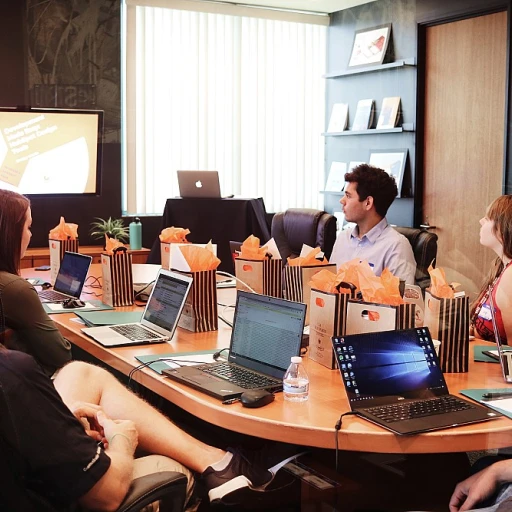
Understanding the Reskilling Landscape
Mapping the Voyage to New Skills
The reskilling landscape has become a pivotal focus in the realm of professional development. As industries continue to evolve, the need for individuals to adapt their skills has intensified. Recent economic shifts and technological advancements have prompted businesses across the United States and globally to rethink their approach to workforce management. This shift highlights the role of learning and development experts, particularly consultants, in guiding organizations through this transition.
Learning and development (L&D) play a crucial role in this changing landscape. Companies are no longer just emphasizing traditional training but are embracing strategies to create a learning culture. This involves focusing efforts on the design and implementation of effective training programs that equip employees with the skills needed to thrive in new roles. A comprehensive understanding of effective strategies is essential to lay the groundwork for a successful reskilling initiative.
The emergence and growing demand for learning solutions means that learning development managers, development consultants, and senior learning specialists are instrumental in shaping these training programs. They are tasked with crafting bespoke learning experiences that align with the unique needs of an organization and its business objectives. This intricate design process ensures a focus on skill acquisition that is in tune with future organizational goals.
Moreover, the expertise of a learning consultant is invaluable in easing the transition for employees moving through various roles. Through insightful learning technology and tailored professional development programs, consultants bridge the gap between the current skill sets of employees and the requirements of their future positions.
Organizations are leveraging their Learning & Development (L&D) departments not only to fill immediate positions but also to anticipate future needs. This forward-thinking approach fosters an environment where reskilled employees are seen as strategic assets. Ultimately, the ability to nurture these skills will determine the competitive edge of businesses in the marketplace.
The Expertise of a Learning and Development Consultant
Consultants as Catalysts for Change
The role of a learning and development consultant is pivotal in shaping and driving the reskilling agenda within organizations. These specialists bring a wealth of expertise in not just training and education, but also in organizational development and strategic management. By understanding the distinct needs and goals of a business, consultants craft tailored learning solutions that align with the long-term growth objectives of the company.
Harnessing the Expertise of Senior Consultants
Seasoned consultants possess in-depth knowledge of instructional design, leadership development, and learning technology, making them invaluable assets in today's job market. They leverage their skills to design effective training programs that meet both employee and organizational needs. These professionals often transition into consultant jobs from senior or managerial positions, armed with the experience and insight necessary to foster an environment of continual learning.
Advising Management on Reskilling
A development consultant also plays a critical advisory role, guiding business managers through the complex landscape of training development. Their input helps managers learning to effectively allocate resources, choose the right learning solutions, and implement programs that facilitate professional development. By acting as a bridge between the training needs and organizational goals, these consultants ensure that reskilling efforts lead to tangible outcomes.
Creating and Customizing Programs
The design of reskilling programs is another key responsibility. Consultants utilize their expertise to develop and tailor training modules that address specific skill gaps. This requires a deep understanding of the current business environment and a forward-thinking approach to anticipate future trends in learning and development. In doing so, consultants ensure the programs remain relevant and impactful over time.
For more insights into navigating the path to reskilling, especially in project management, explore how experts are adapting methodologies to meet the needs of evolving business landscapes. Discover more here.
Strategies for Effective Reskilling
Implementing Tailored Training Programs
For effective reskilling, it is crucial to design training programs that are tailored to the specific needs of the organization and its employees. A learning and development consultant plays a pivotal role in this process by conducting a thorough analysis of the current skills within the workforce and identifying gaps that need to be addressed. By leveraging their expertise, these consultants can develop customized learning solutions that align with both organizational goals and individual career aspirations.
Utilizing Learning Technologies
Incorporating the latest learning technology is essential for modern reskilling strategies. From online platforms to virtual reality simulations, these tools offer innovative ways to engage employees and enhance their learning experience. A development manager or senior learning specialist can integrate these technologies into training programs, ensuring that they are both effective and engaging. This approach not only helps in skill acquisition but also in retaining the learned skills over time.
Fostering a Culture of Continuous Learning
Creating a culture that values continuous learning is vital for the success of reskilling initiatives. This involves encouraging employees to take ownership of their professional development and providing them with opportunities to learn and grow. L&D consultants can work closely with organizational development managers to establish policies and practices that promote ongoing learning. By doing so, businesses can ensure that their workforce remains adaptable and equipped to meet the demands of evolving jobs and industries.
Setting Boundaries for Effective Reskilling
While implementing reskilling strategies, it is important to set clear boundaries to avoid overwhelming employees. This involves defining the scope of training programs and ensuring that they are manageable and focused. A consultant can assist in setting these boundaries by providing insights into the optimal duration and intensity of training sessions. For more insights, explore setting boundaries for effective reskilling.
By adopting these strategies, organizations can effectively reskill their workforce, ensuring that employees are well-prepared for future challenges and opportunities.
Overcoming Barriers to Reskilling
Navigating Challenges in the Reskilling Journey
Overcoming barriers to reskilling is a critical element for any effective Learning and Development Consultant. Organizational challenges, such as aligning new skill sets with business requirements, can hinder reskilling efforts. Addressing these challenges requires a nuanced understanding of both the current job market and the skills necessary for future roles.
One significant challenge is the internal resistance to change. Employees may be apprehensive about leaving their familiar roles to engage in training programs. Furthermore, management might be hesitant to invest in reskilling initiatives due to cost implications or uncertainty about the return on investment. L&D consultants must foster a culture that values continuous learning and development to mitigate such resistance.
Strategies to Mitigate Resistance:
- Early Engagement: Involve employees early in the reskilling design process. By integrating their feedback, organizations can ensure that the training programs resonate and appear relevant to employees of varying senior positions.
- Transparent Communication: Development specialists should communicate the benefits of reskilling programs clearly. Highlight how acquiring new skills might aid in securing consultant jobs or manager roles, enhancing career paths within the organization.
- Leadership Support: More emphasis is needed on securing support from senior management. Leaders can advocate for reskilling investments, showcasing the potential business benefits and improvements in workforce efficiency.
Aside from cultural resistance, practical barriers also pose challenges. Access to the right learning technology is crucial for implementing adaptable and scalable training solutions. Technical hurdles, especially for organizations lacking a robust IT infrastructure, can significantly delay reskilling efforts.
L&D consultants can address these issues by promoting partnerships with technology providers who specialize in organizational development tools. Leveraging advanced learning solutions and instructional design can equip employees with the skills necessary for future roles, ensuring the workforce remains competitive in the evolving job market of the United States and beyond.
Measuring the Impact of Reskilling Programs
The Importance of Evaluating Reskilling Success
The effectiveness of reskilling programs is not merely about delivering new skills; it’s about ensuring those skills are relevant and impactful for both individuals and the organization. Evaluation is crucial for validating whether the learning and development initiatives are meeting their objectives. A development consultant plays a pivotal role in facilitating this evaluation process, often collaborating with the L&D team and development managers.
Key Metrics for Measuring Reskilling Outcomes
To accurately measure the impact of reskilling programs, companies need to develop a comprehensive evaluation framework that includes various KPIs. Some essential metrics might include:
- Employee Performance Metrics: Improvements in job performance post-training, as reviewed by managers.
- Skill Retention Rates: The degree to which employees retain new skills over time.
- Job Placement Rates: How often participants move into new roles or are promoted within the organization post-training.
- Employee Engagement Levels: Tracking changes in engagement and satisfaction can offer insights into the training's cultural impact within the organization.
- Return on Investment (ROI): Tying the cost of training programs to improved performance or organizational outcomes can provide tangible proof of success.
Embedding Feedback Mechanisms in Training Design
A successful reskilling strategy incorporates feedback at every stage from participants, their managers, and L&D consultants. This may involve pre- and post-training surveys, regular review meetings, and even one-on-one feedback sessions facilitated by development specialists. These efforts not only aid in measuring impact but also help adjust strategies and refine training solutions for future programs.
Leveraging Technology in Evaluation Processes
Utilizing learning technology can significantly improve the efficiency and effectiveness of measuring reskilling outcomes. Digital platforms and learning management systems can offer insightful analytics, allowing managers and L&D consultants to track progress and assess skill acquisition in real-time. Additionally, these tools support organizational development by aligning training initiatives with immediate and long-term business goals.
Future Trends in Learning and Development
Emerging Trends in Learning and Development
As the landscape of work continues to evolve, driven by technological advancements and changing business needs, the field of reskilling is also transforming rapidly. Learning and development consultants are at the forefront, helping organizations anticipate and adapt to these changes effectively. Here is a look at some of the future trends shaping the realm of learning and development.
Integration of Advanced Learning Technologies
With the rise of AI-powered tools and platforms, learning development specialists are now integrating advanced learning technologies into their strategies. This trend is enabling more personalized and efficient training programs, making it easier for professionals in manager jobs to keep pace with technological changes. As a consultant, staying abreast of these innovative solutions can offer significant advantages in program design and implementation.
Focus on Lifelong Learning and Continuous Development
The demand for lifelong learning is increasing, with businesses recognizing the need to keep their workforce’s skills up-to-date. Managers, consultants, and senior leadership are now encouraging continuous development, promoting a culture where learning is an ongoing part of job roles. This is particularly essential in places like the United States, where the pace of change is remarkably high.
Prioritization of Soft Skills
Beyond technical expertise, the importance of soft skills is growing. Skills such as leadership development, emotional intelligence, and communication are becoming critical components of organizational success. Development managers are focusing on integrating these skills into their training development programs to enhance overall business performance.
Data-Driven Learning Strategies
Incorporating data analytics to assess the effectiveness of learning solutions is a trend gaining traction. By analyzing feedback and performance metrics, organizational development specialists can tailor programs that meet specific business needs and enhance job performance, ensuring that consulting efforts are impactful and aligned with strategic objectives.
Agility in Learning Design
The rapidly changing business environment necessitates more agile learning solutions. Instructional design is being reimagined to allow for quick updates and flexible implementation, ensuring that training programs remain relevant and effective. Consultants and L&D managers are adopting more adaptive frameworks to cater to dynamic organizational requirements.













